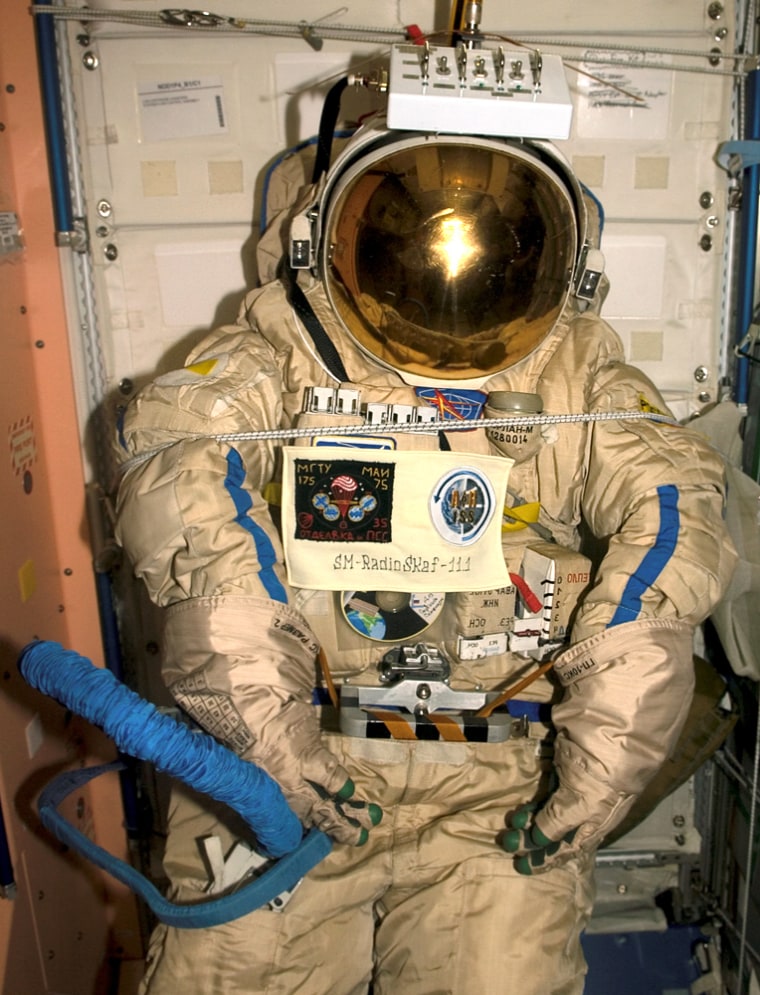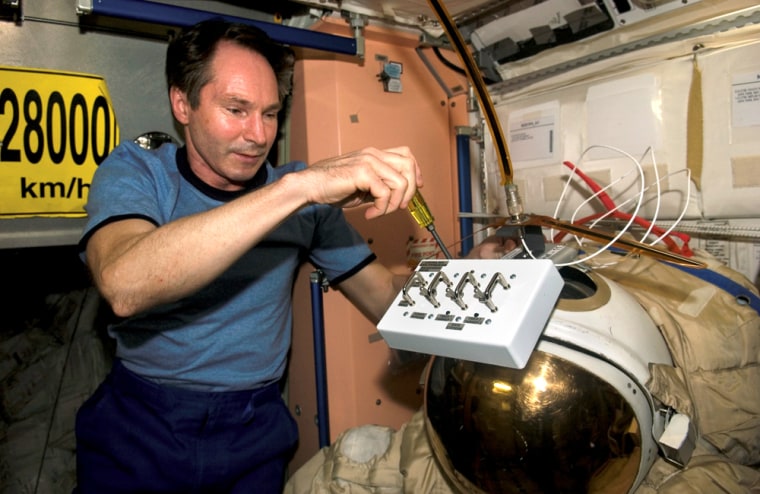It sounds like a scene from science fiction: A lone figure is cast off from the space station, getting smaller and smaller as it drifts out into empty space.
In this case, however, no human will actually be at risk. When the crew members aboard the international space station toss a worn-out spacesuit over the side, it will be empty except for an interesting amateur radio experiment.
During a spacewalk scheduled this Friday, astronaut Bill McArthur and cosmonaut Valery Tokarev will spend six hours carrying out assembly, repair and inspection work on the space station — and one photogenic feat of "space littering."
It won't be the first time an old Russian spacesuit has been tossed overboard, but "SuitSat," as it is called, has an actual mission.
A simple battery-powered radio transmitter inside the suit will use an antenna mounted to the suit's helmet to send signals down to Earth for up to several days. The data will include temperature readings, a slow-scan TV image and several specially coded messages for ham radio listeners to figure out.
The project is aimed mainly at students, and SuitSat organizers solicited hundreds of school pictures, artwork, poems and signatures from schools all over the world. A CD with the imagery is being placed inside Suitsat, with another copy of it to be kept on the space station.
SuitSat's transmitting career will be short, however: Its batteries are expected to run out after several days. Within a few weeks, SuitSat itself will burn up in the atmosphere.
SuitSat’s ancestors
Russia's spacesuits are excellent for working outdoors in orbit. From a spacewalker's perspective, they're flexible, easy to don and doff, and have excellent visibility, including a porthole in the top of the helmet for looking directly overhead. They're also easy to service and, more so than NASA's spacesuits, are designed for repairs in the field.

Still, such suits have a limited life — usually about 10 to 12 spacewalks. The equipment installed on the suits can be cannibalized for use on newer suits, but the bulky main shells must be disposed of. Sometimes they are stuffed into empty supply drones destined to dive back into the atmosphere. Once, a suit was loaded onto a visiting space shuttle for study back on Earth. But usually, the suits are literally thrown away into space, stuffed with other throwaway items such as empty food containers and dirty clothing.
In October 1993, two cosmonauts aboard the Russian space station Mir added a wry visual gimmick: They stuffed the suit full of trash, shaping it into the posture of a cosmonaut standing erect, arm waving goodbye. They then cast it off in full view of their external television camera. As it slowly cartwheeled away, the empty suit looked like that classic science-fiction staple of the doomed astronaut, saluting as it went to a fiery Viking funeral in Earth’s atmosphere.
For years afterwards, cosmonauts entertained guest astronauts by playing a tape of the spacesuit’s final salute. The images were never released to the public — perhaps for fear they could spark sensational rumors. But in 1993 Russia was still using communications relay satellites for television transmissions, and a few dedicated and highly skilled radio amateurs in Europe were able to eavesdrop on the channel and capture the image.
How to tune in to SuitSat
For decades, American and Russian space activities have included projects on behalf of amateur radio operators all around the world. SuitSat — whose "call sign" will be "RS0RS" — will broadcast on a frequency deliberately chosen to be easily accessible.
"All you need is an antenna — the bigger the better — and a radio receiver that you can tune to 145.990 MHz FM," said project engineer Frank Bauer at NASA's Goddard Space Flight Center. "A police band scanner or a hand-talkie ham radio would work just fine."
The satellite will pass across the sky for observers in only a few minutes, so timing is critical.
For the first few days of its deployment, SuitSat will be in the vicinity of the international space station, so you can use or other station-watching sites to keep tabs on SuitSat as well. As SuitSat’s orbit decays, it will gradually drift ahead of the station in its orbital path.
Listeners are asked to log their receptions on the project's home page, , and to keep up on the project’s progress via the , the Radio Amateur Satellite Corp., or through . Updated tracking information will be available from Suitsat.org as well as other sites for skywatchers such as (registration required).
A group known as "SeeSat," which tries to observe space satellites visually, will also try to watch for SuitSat. At best, the small white spacesuit will appear as a dim star — almost too dim for the unaided eye — slowly flashing in the dawn or dusk skies, just ahead of the bright moving dot that is the space station. A group record of the "SeeSat" results, and suggestions for other would-be watchers, can be found on .
Releasing a radio beacon for amateur radio operators to pick up on is not a new idea. In 1997, cosmonauts aboard Mir tossed a subscale replica of the Sputnik 1 satellite into open space in honor of the 40th anniversary of the original feat. It carried an amateur radio beacon that was heard for weeks.
Safety concerns
Dropping SuitSat off the space station isn't as simple as it sounds. The esoteric rules of orbital motion demand that it follow a specific path as it departs from the station. Otherwise, the risk is that it could boomerang back and hit the space station, as a tool dropped during a spacewalk nearly did in 2001.
NASA officials have explained that the SuitSat will be manually shoved directly backwards relative to the station’s immense orbital motion. The two spacewalkers will be standing near the Russian air lock that extends down (toward Earth) from the Russian pressurized modules at one end of the station.
The exact speed at which SuitSat departs will depend on how exactly it is launched, as well as whether it stays clear of the Russian modules as it skims below them. But it probably will be moving between 1 and 2 feet per second. Once it is about 500 to 1,000 feet (150 to 300 meters) out, SuitSat will slow its departure rate, sink into a slightly lower orbit — and begin heading back toward the station.
Fortunately, since SuitSat was thrown into an orbit that has an average speed less than that of the station (by the amount of push the men were able to impart to it), it follows Newton’s Laws and orbits at a slightly lower altitude. This guarantees a miss, but it will still look like a fairly dramatic close call.
Within about another 10 minutes, it will pass beneath the station at a range of 2,000 to 3,000 feet (600 to 900 meters). As it slips downhill into its new orbit, SuitSat will pick up speed and will seem to be traveling in the opposite direction that it originally left the space station.
The only ones likely to see it during this phase are the spacewalkers. The small spacesuit is too close to the giant space station for ground radar to notice it (there is no radar on board the station), and ground observers won’t be able to spot it until it approaches sunset and the ground below is in darkness.
After one 92-minute orbit, SuitSat should wind up between 3 to 5 miles (5 and 8 kilometers) ahead of the space station and continue to move ahead at that rate, according to a NASA trajectory officer. After a full day of free flight, Suitsat will thus be at least 50 miles (80 kilometers) ahead of the station, or about 10 seconds at the speed the objects are orbiting.
SuitSat will never return to the vicinity of the station. While pulling ahead hour by hour, the separation rate will increase as air drag (which affects the light suit much more than the massive station) drops the suit into an even lower orbit that in turn makes it speed up and pull away even more quickly.
A tricky throw
This separation profile may seem scary, but it’s safer than any alternative. The laws of orbital motion have logical — but unearthly — consequences for departures in any other direction.
Just throwing it straight down, for example, is among the worst choices. Since the speed is imparted crosswise to the object’s original forward motion, it makes practically no change in the total speed — so the resulting orbit will be uncomfortably parallel to the station’s.
With an impulse of 1 foot per second, the jettisoned object would drop for a few minutes and then begin pulling ahead. But with its absolute speed undiminished, it would then begin to coast uphill, and soon would be crossing the station’s orbit, about a mile in front. It would continue to rise, slip backward, then begin falling again — and smash back into the station with the same speed but from the opposite direction it was thrown at.
Throwing straight up has the same results but with a mirror image. And throwing sideways results in the object boomeranging back in half the time the up-down jettison causes.
Throwing it forward results in a higher, slower orbit that sees the object pass overhead and disappear to the rear. But then the long-term effects of air drag cause it to slip into a lower, faster orbit and it begins to overtake the station, threatening to impact with many times the speed it departed with.
So when SuitSat takes its walk into space, there is only one safe path for the space crew to strive for, since they don’t ever want to see it come back. Like the jettisoned spacesuits from Mir, SuitSat will be aimed straight backward. Them’s the rules of the road in Earth orbit.
